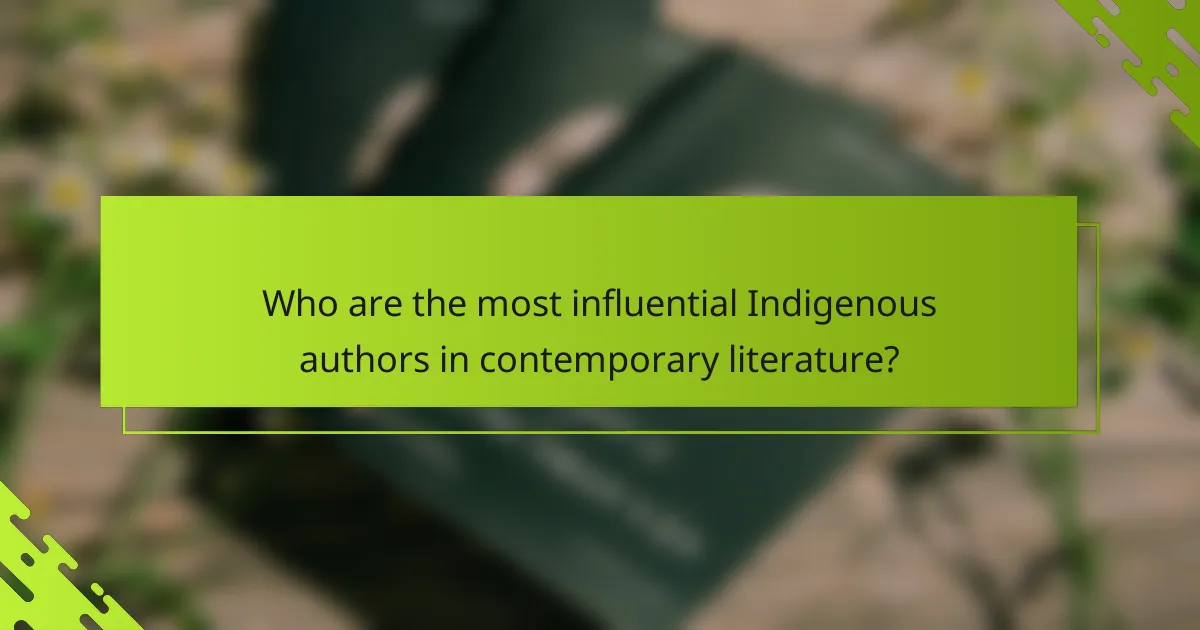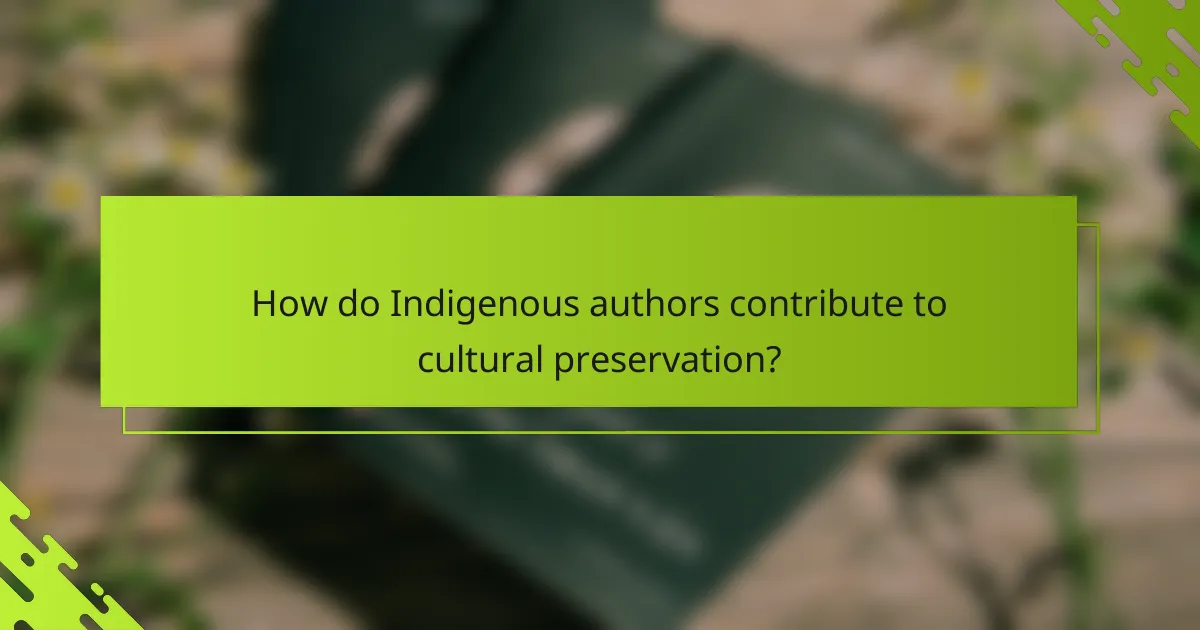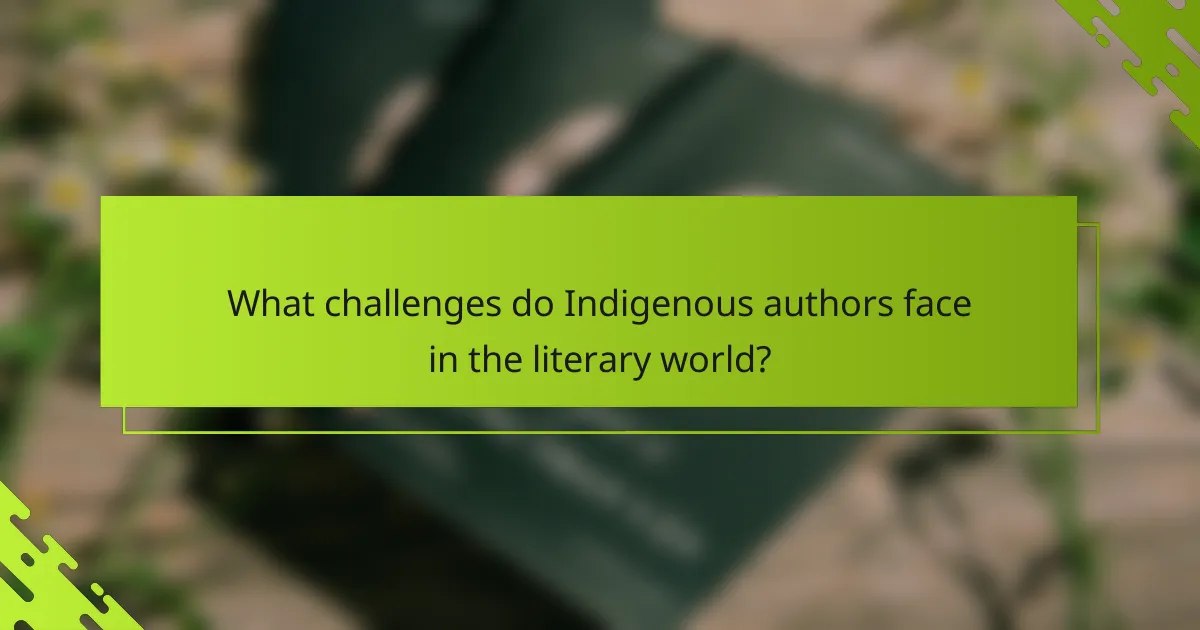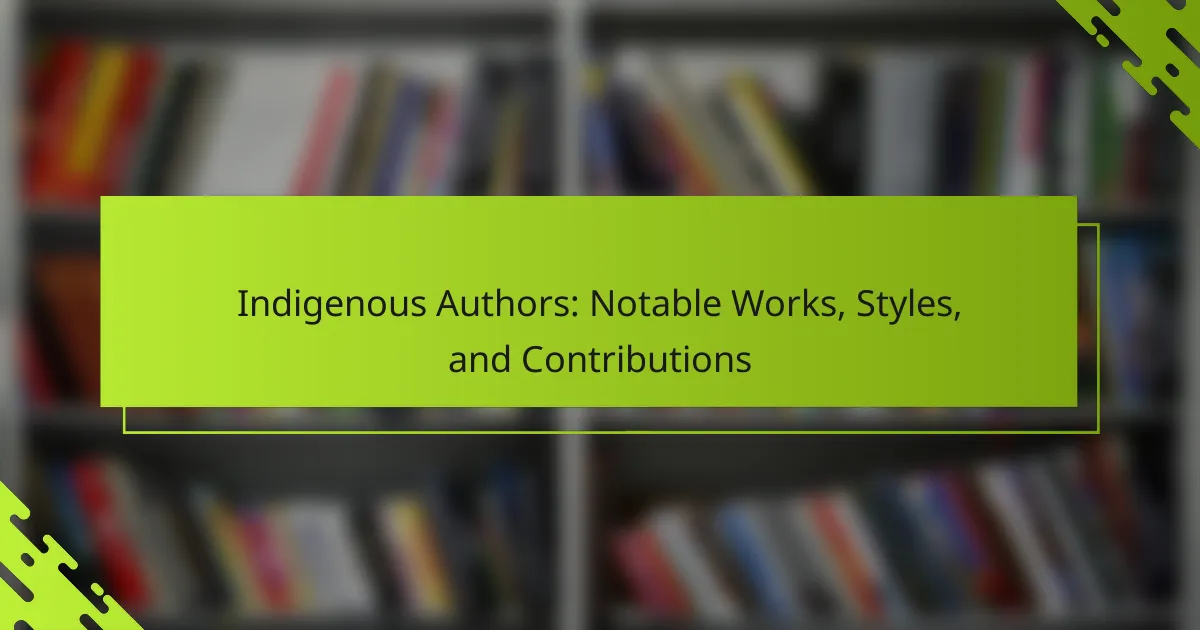Indigenous authors significantly influence literature by sharing unique perspectives on identity, cultural heritage, and social justice. Notable figures like Louise Erdrich and Sherman Alexie employ innovative storytelling techniques that blend traditional narratives with contemporary themes. Their works highlight the importance of cultural preservation and challenge stereotypes while addressing the systemic barriers they face in the literary world. Emerging trends in Indigenous literature showcase increased representation and a focus on community narratives, enriching the overall literary landscape.

What are the key themes explored by Indigenous authors?
Indigenous authors explore themes of identity, cultural heritage, social justice, and connection to land. Their works often reflect personal and collective experiences, addressing historical trauma and resilience. Additionally, they highlight the importance of storytelling and oral traditions in preserving culture. These themes contribute to a broader understanding of Indigenous perspectives and challenges faced in contemporary society.
How do cultural narratives shape Indigenous literature?
Cultural narratives significantly influence Indigenous literature by providing a framework for storytelling and identity. These narratives often reflect historical experiences, traditions, and values unique to Indigenous communities.
Indigenous authors utilize these narratives to address contemporary issues, weaving cultural elements into their works. Notable contributions include the emphasis on oral traditions, which preserve language and ancestral knowledge. For example, authors like Thomas King and Louise Erdrich integrate personal and collective histories to challenge stereotypes and promote understanding.
The unique attributes of Indigenous literature often stem from its connection to place and spirituality. This literature serves not only as entertainment but also as a medium for cultural preservation and social justice. Through their stories, Indigenous authors foster a deeper appreciation for their heritage and advocate for their communities.
Which social issues are often highlighted in their works?
Indigenous authors often highlight social issues such as cultural identity, land rights, and historical injustices. Their works frequently address themes of resilience, community, and the impacts of colonization. For example, authors like Louise Erdrich and Thomas King explore the complexities of Indigenous life and the ongoing struggles faced by their communities. Their narratives often serve as a platform for raising awareness and fostering understanding of these pressing social matters.

Who are the most influential Indigenous authors in contemporary literature?
Some of the most influential Indigenous authors in contemporary literature include Louise Erdrich, Sherman Alexie, and N. Scott Momaday. Their works explore themes of identity, culture, and resilience, contributing significantly to the literary landscape.
Louise Erdrich’s novels often reflect her Native American heritage and explore complex family dynamics. Sherman Alexie is known for his poignant storytelling and humour, addressing contemporary Indigenous life. N. Scott Momaday’s poetry and prose draw on his Kiowa roots, emphasizing the connection to nature and spirituality.
These authors have received numerous awards, such as the National Book Award and the Pulitzer Prize, highlighting their impact on literature and cultural discourse. Their unique perspectives enrich the understanding of Indigenous experiences and narratives in modern society.
What notable works have defined their careers?
Indigenous authors have produced notable works that have significantly defined their careers. For instance, Louise Erdrich’s “Love Medicine” explores Native American life through interconnected stories. Sherman Alexie’s “The Lone Ranger and Tonto Fistfight in Heaven” blends humour and tragedy in contemporary Native experiences. N. Scott Momaday’s “House Made of Dawn” won the Pulitzer Prize and is a seminal work in Native American literature. These works showcase unique storytelling styles and cultural perspectives, highlighting the rich contributions of Indigenous authors to the literary world.
How do their backgrounds influence their writing styles?
Indigenous authors’ backgrounds significantly shape their writing styles through cultural heritage, personal experiences, and historical context. Their narratives often reflect traditional storytelling methods, weaving in community values and spiritual beliefs. For instance, the use of oral history and symbolism is prevalent, showcasing unique perspectives on identity and resilience. Additionally, the impact of colonization and its lasting effects on Indigenous communities influences themes of struggle and survival in their works. This blend of cultural and historical elements results in distinctive literary voices that resonate with authenticity and depth.

What unique storytelling techniques are employed by Indigenous authors?
Indigenous authors employ unique storytelling techniques that reflect cultural heritage and communal values. They often use oral traditions, blending myth with personal narrative to create deep connections to land and identity.
These authors frequently incorporate symbolism and metaphor, drawing from nature and ancestral teachings. Their works may also feature non-linear narratives, allowing for a more immersive experience that mirrors Indigenous worldviews.
Additionally, the use of Indigenous languages enriches the storytelling, providing authenticity and preserving linguistic heritage. These techniques not only engage readers but also educate them about Indigenous perspectives and histories.
How do oral traditions influence written narratives?
Oral traditions profoundly shape written narratives by embedding cultural values and storytelling techniques. Indigenous authors often draw from these traditions, enriching their works with unique perspectives and styles. The oral storytelling methods emphasize rhythm, repetition, and communal participation, which influence narrative structure and character development in written forms. For example, the use of metaphor and symbolism in oral traditions often translates into rich imagery in written texts, allowing for deeper emotional connections. This interplay between oral and written forms highlights the importance of cultural heritage in shaping contemporary literature.
What role does symbolism play in their works?
Symbolism plays a crucial role in the works of Indigenous authors by conveying cultural narratives and spiritual beliefs. These authors often use symbols to represent their connection to nature, community, and ancestral heritage. For instance, the use of animals or natural elements can reflect deeper meanings tied to identity and tradition. This unique attribute of symbolism allows Indigenous literature to communicate complex themes and values, enriching the reader’s understanding of Indigenous perspectives. By employing symbolism, these authors preserve and share their cultural histories, fostering a greater appreciation for their contributions to literature.

How do Indigenous authors contribute to cultural preservation?
Indigenous authors play a crucial role in cultural preservation by sharing their stories and traditions through literature. Their works often reflect unique perspectives, languages, and histories that are vital for maintaining cultural identity.
Notable Indigenous authors, such as Louise Erdrich and Sherman Alexie, utilize distinctive narrative styles that blend traditional storytelling with modern themes. These contributions help educate wider audiences about Indigenous cultures and issues, fostering greater understanding and appreciation.
Through literature, Indigenous authors document oral histories, promote language revitalization, and challenge stereotypes. Their unique attributes, like personal experiences and cultural insights, enrich the literary landscape while preserving essential aspects of their heritage.
As a result, the impact of Indigenous authors extends beyond literature; it influences cultural dialogue and encourages the recognition of Indigenous rights and histories.
Which specific literary forms are used to convey cultural heritage?
Indigenous authors use various literary forms to convey cultural heritage, including oral traditions, poetry, novels, and essays. These forms encapsulate unique narratives that reflect community values and historical experiences. For example, oral storytelling preserves ancestral knowledge and fosters communal ties. Poetry often employs symbolism and imagery to express identity and connection to the land. Novels can explore complex social issues, while essays provide critical reflections on contemporary challenges faced by Indigenous peoples. Each form serves to enrich cultural understanding and promote awareness of Indigenous perspectives.
What impact do their works have on Indigenous identity?
Indigenous authors significantly shape Indigenous identity through their works. They express cultural narratives, challenge stereotypes, and promote historical awareness. This literature fosters a sense of belonging and pride among Indigenous communities. For example, authors like Louise Erdrich and Thomas King highlight unique experiences and perspectives, reinforcing cultural resilience. Their storytelling often intertwines personal and collective histories, creating a deeper understanding of Indigenous identity.

What challenges do Indigenous authors face in the literary world?
Indigenous authors face numerous challenges in the literary world, including cultural misrepresentation and lack of access to publishing opportunities. Many struggle with stereotypes that overshadow their unique voices and stories. Additionally, systemic barriers often limit their visibility in mainstream literature. The underrepresentation of Indigenous perspectives in literary circles further complicates their ability to connect with broader audiences.
How does the publishing industry respond to Indigenous voices?
The publishing industry increasingly amplifies Indigenous voices through diverse platforms and initiatives. Indigenous authors are gaining recognition for their unique storytelling styles and cultural contributions.
Notable works by Indigenous authors include “The Night Watchman” by Louise Erdrich and “There There” by Tommy Orange. These books explore themes of identity and resilience, reflecting the rich heritage of Indigenous cultures.
The industry responds by prioritising authentic narratives and supporting Indigenous-led publishing houses. As a result, Indigenous authors are more visible in mainstream literature, fostering greater understanding and appreciation of their experiences.
This shift enhances the literary landscape, allowing Indigenous voices to resonate widely and influence contemporary storytelling.
What barriers exist for reaching broader audiences?
Barriers for reaching broader audiences include limited access to publishing resources, cultural misrepresentation, and lack of marketing support. Indigenous authors often face challenges in visibility due to systemic biases in the literary industry. Additionally, language barriers and regional isolation can hinder their works from gaining wider recognition. These factors contribute to the underrepresentation of Indigenous voices in mainstream literature.

Why is representation of Indigenous authors important in global literature?
Representation of Indigenous authors is crucial in global literature because it amplifies diverse voices and perspectives. Indigenous narratives challenge dominant cultural norms and enrich the literary landscape. Their unique contributions often reflect profound connections to land, identity, and community, showcasing a rich tapestry of experiences. Notable works by authors like Louise Erdrich and Thomas King highlight themes of resilience and cultural heritage, fostering greater understanding and empathy among readers. Furthermore, increased visibility of Indigenous authors can inspire future generations, ensuring that their stories continue to be told and celebrated.
How does diversity in literature enrich the reading experience?
Diversity in literature enriches the reading experience by providing varied perspectives and cultural insights. Indigenous authors contribute unique narratives that reflect their histories, traditions, and worldviews. Their notable works often explore themes of identity, resilience, and connection to the land, which fosters empathy and understanding among readers. For example, authors like Louise Erdrich and Tommy Orange use distinct storytelling styles that blend oral traditions with contemporary issues. This diversity not only enhances the literary landscape but also invites readers to engage with complex social realities.
What role do Indigenous authors play in educating non-Indigenous readers?
Indigenous authors play a crucial role in educating non-Indigenous readers by sharing unique perspectives and cultural narratives. Their works often highlight historical injustices and contemporary issues faced by Indigenous communities. For example, authors like Thomas King and Louise Erdrich use storytelling to bridge cultural gaps and foster understanding. Their contributions enrich the literary landscape and promote empathy, encouraging readers to engage with Indigenous histories and worldviews. By presenting their experiences authentically, Indigenous authors challenge stereotypes and inspire critical conversations about identity and belonging.

What are the emerging trends in Indigenous literature?
Emerging trends in Indigenous literature include increased representation, innovative storytelling techniques, and a focus on community narratives. Indigenous authors are embracing digital platforms to reach wider audiences. They are also blending traditional oral storytelling with contemporary forms, enriching the literary landscape. The emphasis on environmental themes reflects Indigenous connections to land and culture, showcasing unique perspectives.
How is technology influencing the way Indigenous stories are told?
Technology is profoundly reshaping how Indigenous stories are conveyed. Digital platforms enable wider reach and accessibility, allowing Indigenous authors to share their narratives globally.
Social media serves as a tool for storytelling, fostering community engagement and dialogue. This interaction enriches the narrative, as audiences contribute their perspectives.
Multimedia formats, including video and podcasts, enhance storytelling by integrating visual and auditory elements. This approach captures the richness of Indigenous culture more effectively than traditional text alone.
Moreover, technology allows for the preservation of languages and oral traditions through digital archiving. This ensures that Indigenous stories remain vibrant and accessible for future generations.
Which new voices are gaining recognition in the literary scene?
Indigenous authors are gaining significant recognition for their unique storytelling and cultural perspectives. Notable voices include Tommy Orange, whose novel “There There” explores urban Native American identity, and Louise Erdrich, known for her intricate narratives that weave together personal and historical themes. Their contributions highlight diverse styles, often blending traditional oral storytelling with contemporary issues. This growing recognition reflects a broader appreciation for Indigenous literature in the literary scene.
What best practices should aspiring Indigenous authors consider?
Aspiring Indigenous authors should prioritise authenticity, cultural representation, and storytelling techniques. They must engage with their communities and research their heritage to ensure accurate depictions. Understanding the publishing landscape and building networks are crucial for success. Emphasising unique narratives enriches the literary world and fosters broader cultural understanding.
